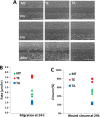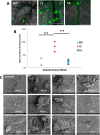Post-translational modification of the membrane type 1 matrix metalloproteinase (MT1-MMP) cytoplasmic tail impacts ovarian cancer multicellular aggregate dynamics
- PMID: 28655772
- PMCID: PMC5555175
- DOI: 10.1074/jbc.M117.800904
Post-translational modification of the membrane type 1 matrix metalloproteinase (MT1-MMP) cytoplasmic tail impacts ovarian cancer multicellular aggregate dynamics
Abstract
Membrane type 1 matrix metalloproteinase (MT1-MMP, MMP-14) is a transmembrane collagenase highly expressed in metastatic ovarian cancer and correlates with poor survival. Accumulating evidence shows that the cytoplasmic tail of MT1-MMP is subjected to phosphorylation, and this post-translational modification regulates enzymatic activity at the cell surface. To investigate the potential role of MT1-MMP cytoplasmic residue Thr567 phosphorylation in regulation of metastasis-associated behaviors, ovarian cancer cells that express low endogenous levels of MT1-MMP were engineered to express wild-type MT1-MMP, a phosphomimetic mutant (T567E), or a phosphodeficient mutant (T567A). Results show that Thr567 modulation influences behavior of both individual cells and multicellular aggregates (MCAs). The acquisition of either wild-type or mutant MT1-MMP expression results in altered cohesion of epithelial sheets and the formation of more compact MCAs relative to parental cells. Cells expressing MT1-MMP-T567E phosphomimetic mutants exhibit enhanced cell migration. Furthermore, MCAs formed from MT1-MMP-T567E-expressing cells adhere avidly to both intact ex vivo peritoneal explants and three-dimensional collagen gels. Interaction of these MCAs with peritoneal mesothelium disrupts mesothelial integrity, exposing the submesothelial collagen matrix on which MT1-MMP-T567E MCAs rapidly disperse. Together, these findings suggest that post-translational regulation of the Thr567 in the MT1-MMP cytoplasmic tail may function as a regulatory mechanism to impact ovarian cancer metastatic success.
Keywords: cadherin; matrix metalloproteinase (MMP); metastasis; migration; ovarian cancer.
© 2017 by The American Society for Biochemistry and Molecular Biology, Inc.
Conflict of interest statement
The authors declare that they have no conflicts of interest with the contents of this article
Figures






References
-
- Siegel R. L., Miller K. D., and Jemal A. (2016) Cancer statistics, 2016. CA Cancer J. Clin. 66, 7–30 - PubMed
-
- Naora H., and Montell D. J. (2005) Ovarian cancer metastasis: integrating insights from disparate model organisms. Nat. Rev. Cancer 5, 355–366 - PubMed
-
- Burleson K. M., Casey R. C., Skubitz K. M., Pambuccian S. E., Oegema T. R. Jr, and Skubitz A. P. (2004) Ovarian carcinoma ascites spheroids adhere to extracellular matrix components and mesothelial cell monolayers. Gynecol. Oncol. 93, 170–181 - PubMed
Publication types
MeSH terms
Substances
Grants and funding
LinkOut - more resources
Full Text Sources
Other Literature Sources
Medical
Molecular Biology Databases

